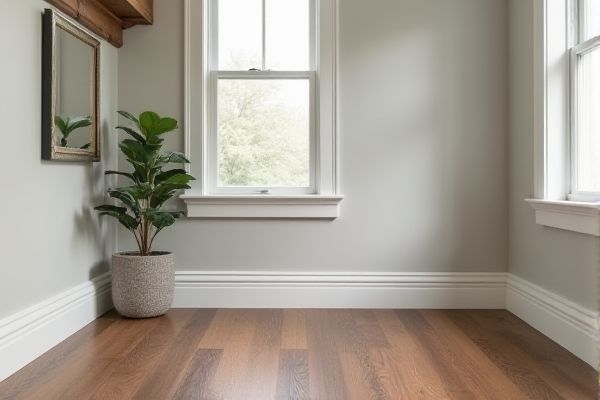
Mudroom cove base offers superior water resistance and easy cleaning compared to traditional wood baseboards, making it ideal for high-moisture areas like mudrooms. Explore the full article to understand the benefits and choose the best option for your home's durability and style.
Table of Comparison
| Feature | Mudroom Cove Base | Wood Baseboard |
|---|---|---|
| Material | Durable vinyl or rubber, water-resistant | Solid wood or MDF, vulnerable to moisture |
| Water Resistance | High resistance to water and mud | Low resistance, can warp or rot with moisture |
| Design | Concave shape, practical for mudrooms | Flat or decorative, wide design options |
| Durability | Highly durable, resists dirt and cleaning chemicals | Moderate durability, prone to scratches and dents |
| Installation | Easy to install, snaps or adhesives | Requires nails, glue, and finishing |
| Maintenance | Low maintenance, easy to clean | Requires painting or staining, regular upkeep |
| Cost | Moderate, cost-effective for mudrooms | Varies, generally higher due to material quality |
| Best Use | Mudrooms, high-moisture areas | Living rooms, bedrooms, decorative spaces |
Introduction to Mudroom Baseboard Choices
Mudroom cove base provides superior water resistance and durability compared to traditional wood baseboards, making it ideal for high-moisture areas like mudrooms. Its curved design helps prevent dirt and grime buildup, enhancing both functionality and ease of cleaning. Choosing the right baseboard ensures your mudroom remains both stylish and practical for everyday use.
What Is a Cove Base in a Mudroom?
A cove base in a mudroom is a curved, seamless molding installed where the floor meets the wall, designed to prevent dirt, water, and debris from accumulating in corners. Unlike traditional wood baseboards, cove bases are typically made from vinyl or rubber, offering increased durability and water resistance ideal for high-traffic, moisture-prone areas. This makes cove bases especially practical in mudrooms, ensuring easier cleaning and enhanced protection against damage from wet shoes and outdoor elements.
Understanding Traditional Wood Baseboards
Traditional wood baseboards offer classic durability and natural warmth, often crafted from hardwoods like oak or maple that resist wear and can be painted or stained. Unlike Mudroom Cove Base, which features a curved profile that directs water away and enhances moisture resistance, wood baseboards provide a flat surface ideal for seamless wall transitions and aesthetic appeal. Their versatility makes wood baseboards a preferred choice in living areas where moisture exposure is minimal.
Durability: Cove Base vs. Wood Baseboard
Cove base in mudrooms offers superior durability due to its moisture resistance and ability to withstand frequent cleaning, making it ideal for high-traffic and wet areas. Wood baseboards, while aesthetically pleasing, are prone to warping, swelling, and damage from water exposure, reducing their lifespan in damp environments. Your choice should prioritize cove base for durability in mudroom settings where moisture and wear are common concerns.
Moisture Resistance Comparison
Mudroom cove base offers superior moisture resistance compared to traditional wood baseboards, making it ideal for areas prone to humidity and water exposure. Unlike wood baseboards that can warp, swell, or develop mold when exposed to moisture, cove base materials such as vinyl or rubber provide a durable, water-resistant barrier. This moisture-resistant quality ensures longevity and low maintenance in mudrooms, laundry rooms, and other damp environments.
Installation Differences and Considerations
Mudroom cove base installations typically require moisture-resistant materials and flexible profiles to accommodate wet conditions, unlike wood baseboards that demand precise cutting and finishing for a polished look. You should consider the durability and water resistance of cove base options, which simplify maintenance and reduce potential water damage compared to traditional wood baseboards. Installation of wood baseboards often involves nailing and caulking, while mudroom cove bases may use adhesive application or specialized fasteners for quicker, more secure placement in damp environments.
Maintenance and Cleaning Factors
Mudroom cove bases offer superior resistance to moisture and dirt, making maintenance and cleaning easier compared to wood baseboards, which can warp or stain from water exposure. Wood baseboards require regular sealing or repainting to prevent damage, while cove bases typically need only simple wiping to maintain cleanliness. Choosing a mudroom cove base can reduce your cleaning time and upkeep costs in high-traffic or damp areas.
Aesthetic and Design Options
Mudroom cove base offers a sleek, modern look with its curved profile that seamlessly blends with flooring, enhancing minimalist and contemporary design themes. Wood baseboards provide a traditional, warm aesthetic with versatile staining or painting options, allowing customization to match various interior styles. The choice between cove base and wood baseboard significantly impacts the mudroom's visual appeal, with cove base favoring a clean, unified design and wood baseboard emphasizing texture and architectural detail.
Cost Comparison: Cove Base vs. Wood Baseboard
Cove base typically costs between $1 to $3 per linear foot, making it a budget-friendly option compared to wood baseboards, which range from $3 to $10 per linear foot depending on the wood species and finish. Installation costs for cove base are generally lower due to its flexible material and ease of cutting, while wood baseboards require more precise measuring and potentially professional carpentry. Overall, cove base offers a cost-effective and practical solution for moisture-prone areas, whereas wood baseboards provide durability and aesthetic appeal at a higher price point.
Which Is Best for Your Mudroom?
Mudroom cove base is best for areas prone to moisture and dirt, as its curved design prevents debris buildup and is easier to clean compared to wood baseboards, which can absorb water and deteriorate over time. Wood baseboards offer a classic, warm aesthetic and can be painted or stained to match your mudroom decor, but they require regular maintenance to avoid warping or damage from mud and water. Choosing between the two depends on your mudroom's exposure to elements and your preference for durability versus style.
 homyna.com
homyna.com